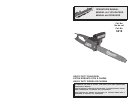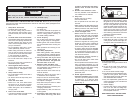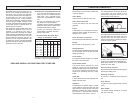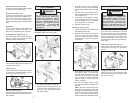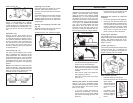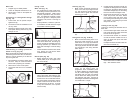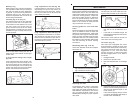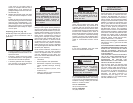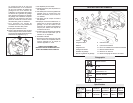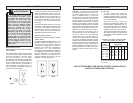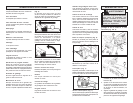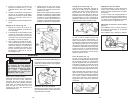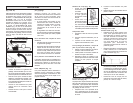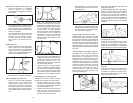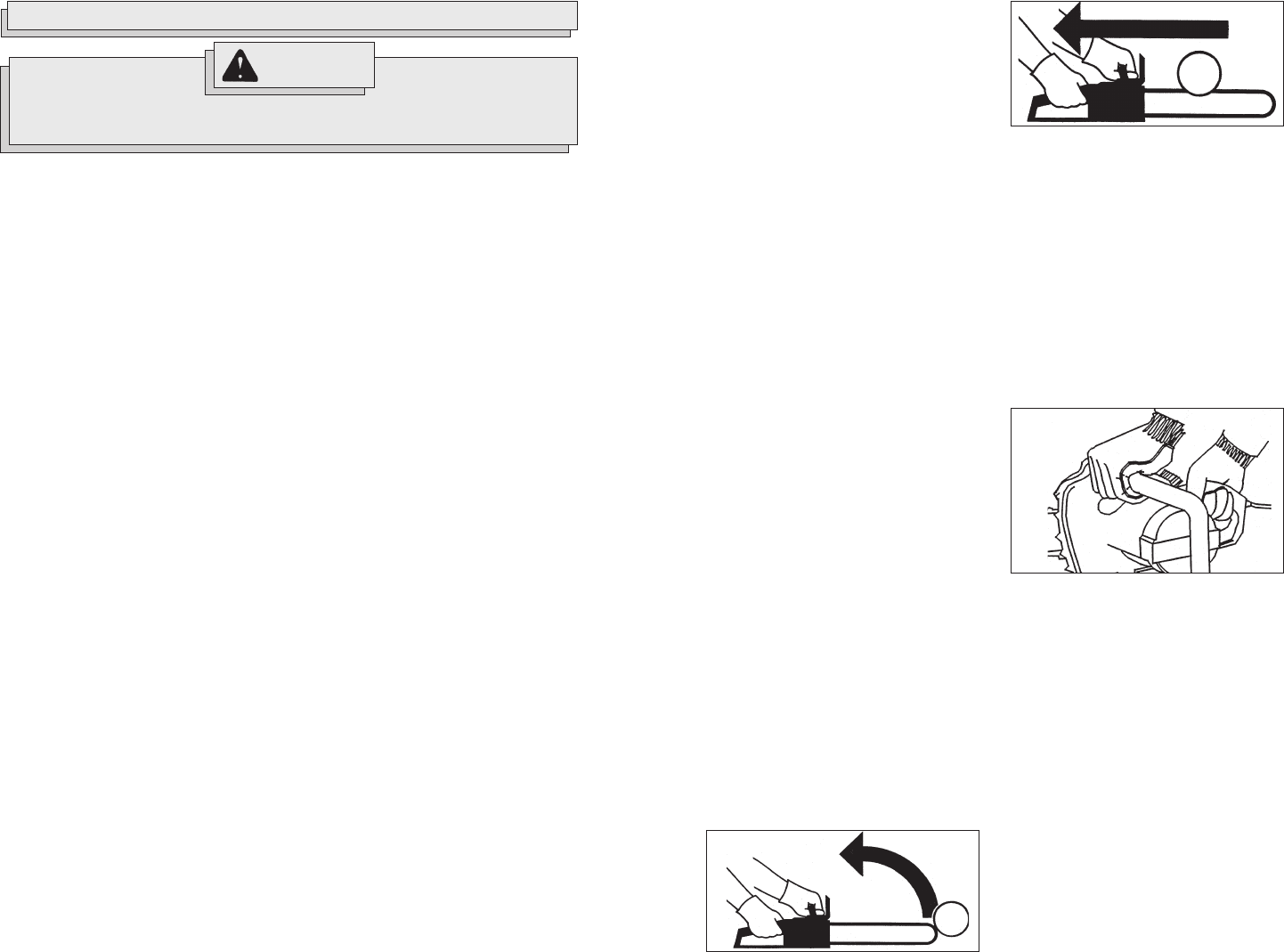
2 3
WARNING!
When using an electric chain saw, always follow basic safety precautions to
reduce the risk of fire, electric shock and personal injury.
GENERAL SAFETY RULES
changing accessories and attach-
ments, such as saw chain and
guard.
13. Outdoor Use extension cords.
Use only extension cords intended for
use outdoors and so marked.
14. Stay Alert.
Watch what you are doing.
Use common sense.
Do not operate chain saw when you
are tired.
Keep all parts of the body away from the
saw chain when the motor is operating.
Before you start the saw, make sure the
saw chain is not contacting anything.
15. Check Damaged Parts.
Before further use of the chain saw, a
guard or other part that is damaged
should be carefully checked to deter-
mine that it will operate properly and
perform its intended function.
Check for alignment of moving parts,
binding of moving parts, breakage of
parts, mounting, and any other condi-
tions that may affect its operation.
A guard or other part that is damaged
should be properly repaired or replaced
by an authorized service center un-
less otherwise indicated elsewhere in
this instruction manual.
Have defective switches replaced by
authorized service center.
Do not use chain saw if switch does
not turn it on and off.
Do not operate a chain saw that is dam-
aged, improperly adjusted, or is not
completely and securely assembled. Be
sure that the saw chain stops moving
when the trigger is released.
When servicing use only identical re-
placement parts.
16. Guard Against Kickback.
WARNING: KICKBACK may occur when
the nose or tip of the guide bar touches
an object (Fig. 1), or when the wood
closes in and pinches the saw chain in
the cut (Fig. 2).
Fig. 1
Tip contact in some cases may cause a
lightning fast reverse reaction, kicking
the guide bar up and back towards the
operator. Pinching the saw chain along
the top of the guide bar may push the
guide bar rapidly back towards the op-
erator. Either of these reactions may
cause you to lose control of the saw
which could result in serious injury to user.
The following precautions should be
followed to minimize kickback:
A.Grip Saw Firmly.
B. Hold the chain saw firmly with both
hands when the motor is running. Use
a firm grip with thumbs and fingers en-
circling the chain saw handles (Fig. 3).
READ AND SAVE ALL INSTRUCTIONS FOR FUTURE USE. Before use, be sure everyone
using this tool reads and understands this manual as well as any labels packaged with or
attached to the tool.
1. Keep Work Area Clean.
Cluttered areas invite injuries.
Do not start cutting until you have a
clear work area, secure footing, and a
planned retreat path from the falling
tree.
2. Consider Work Area Environment.
Use extreme caution when cutting small
size brush and saplings because the
slender material may catch the saw
chain and be whipped toward you or
pull you off balance.
Do not operate a chain saw in a tree
unless specifically trained to do so.
When cutting a limb that is under ten-
sion be alert for spring back so that
you will not be struck when the tension
in the wood fibers is released.
Do not expose chain saw to rain.
Do not use chain saw in damp or wet
locations.
Do not use chain saw in presence of
flammable liquids or gases.
3. Guard Against Electric Shock.
Prevent body contact with grounded
surfaces such as metal pipes or wire
fences.
4. Keep Children Away.
Do not let visitors contact chain saw or
extension cord.
All visitors should be kept away from
work area.
5. Store Idle Chain Saw.
When not in use, chain saws should
be stored in a dry, and high or locked-
up place, out of the reach of children.
When storing saw, use a scabbard or
carrying case.
6. Dont Force Chain Saw.
It will do the job better and safer at the
rate for which it was intended.
7. Use Right Tool.
Cut wood only.
Do not use chain saw for purpose not
intended, for example, Dont use chain
saw for cutting plastic, masonry, or
non-wood building materials.
8. Dress Properly.
Do not wear loose clothing or jewelry.
They can get caught in moving parts.
Rubber gloves and non-skid footwear
are recommended when working out-
doors.
Wear protective hair covering to con-
tain long hair.
9. Use Safety Equipment.
Wear safety glasses, safety footwear,
snug fitting clothing, protective gloves,
hearing protection and head protection.
10. Carry the chain saw by the front
handle with the saw stopped, fin-
ger off the switch, the guide bar
and saw chain to the rear.
11. Maintain Chain Saw With Care.
Inspect chain saw cords periodically
and if damaged, have repaired by au-
thorized service facility.
Keep cord clear of the chain and op-
erator at all times.
Never carry saw by the cord or pull it
to disconnect from receptacle.
Keep cord from oil and sharp edges.
Inspect extension cords periodically
and replace if damaged.
Keep tools sharp and clean for better
and safer performance.
Follow instructions for lubricating and
changing accessories.
Keep handles dry, clean, and free from
oil and grease.
12. Disconnect chain saw when not in
use, before servicing, and when
Fig. 3
Fig. 2
C. Do not over reach.
D. Keep proper footing and balance at all
times.
E. Do not let the nose of the guide bar
contact a log, branch, ground or other
obstruction.
F. Do not cut above shoulder height.
G.Use devices such as low kickback chain,
guide bar nose guards, chain brakes
and special guide bars that reduce the
risks associated with kickback.
H. Only use replacement guide bars and
chains specified by the manufacturer
or the equivalent.
17. Power Supply
Connect chain saw to correct voltage,
that is, be sure that the voltage sup-
plied is the same as that specified on
the nameplate of the tool.
READ AND SAVE ALL INSTRUCTIONS
FOR FUTURE REFERENCE.



